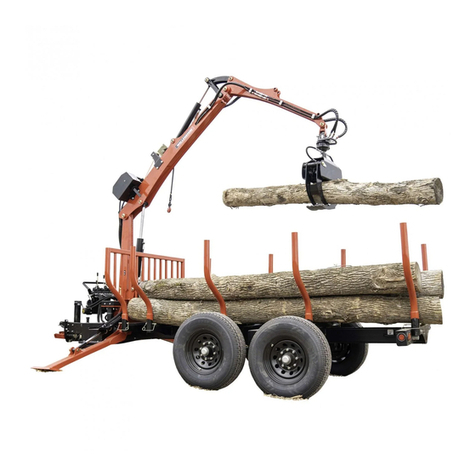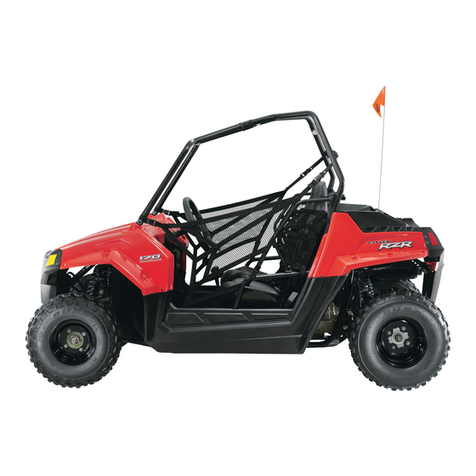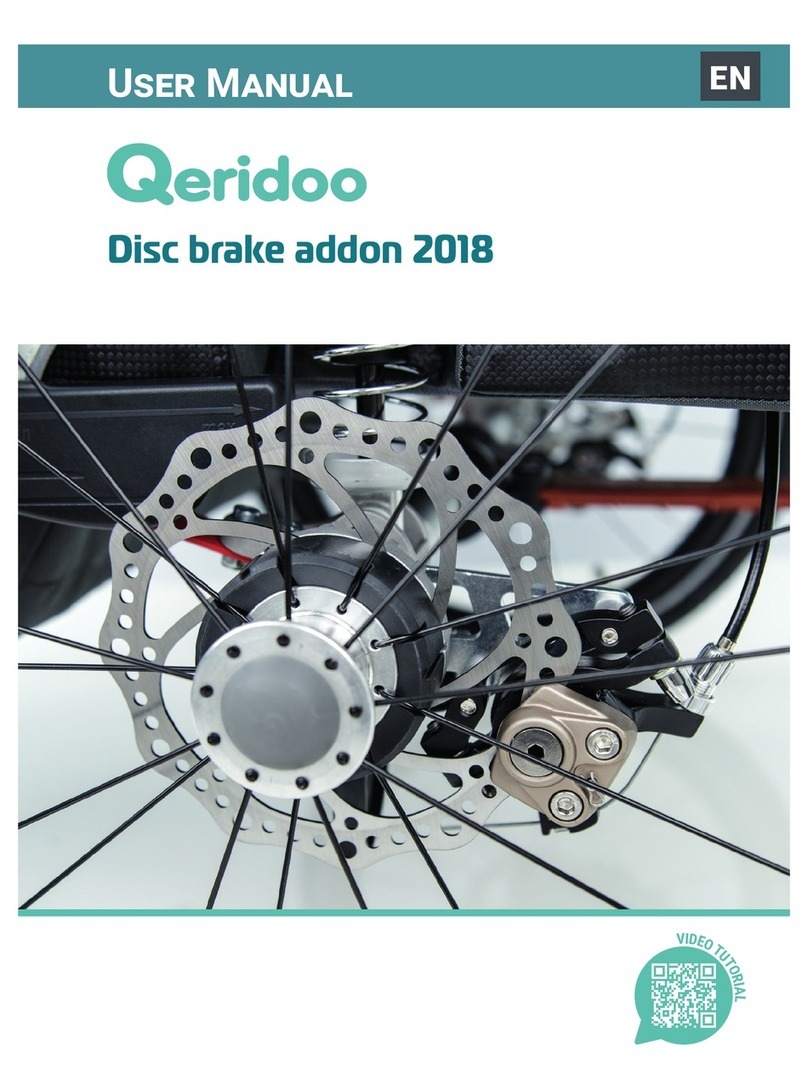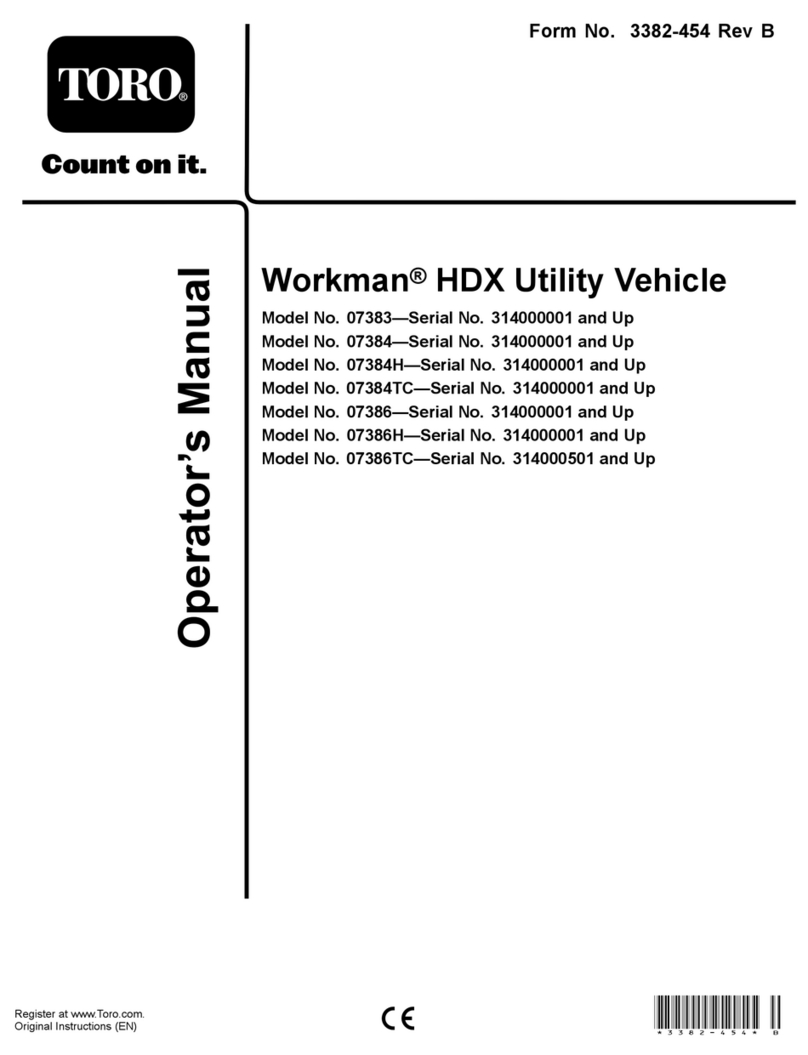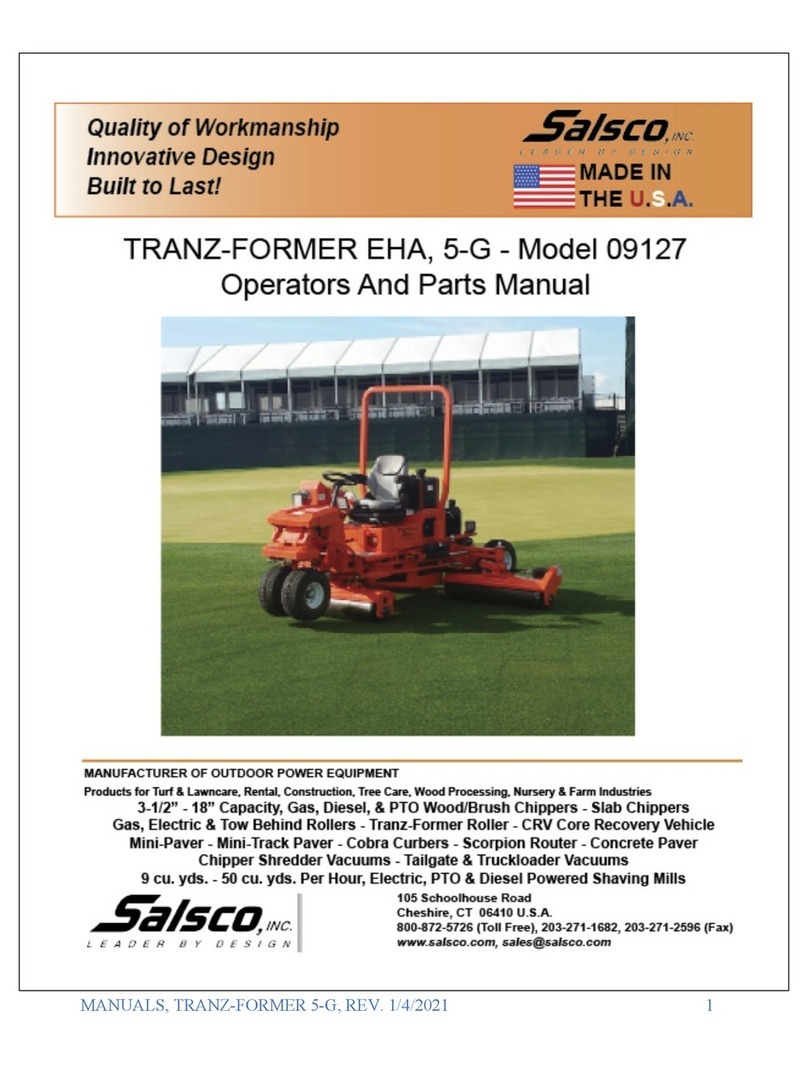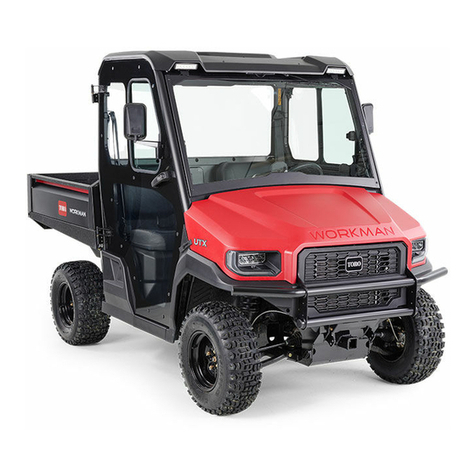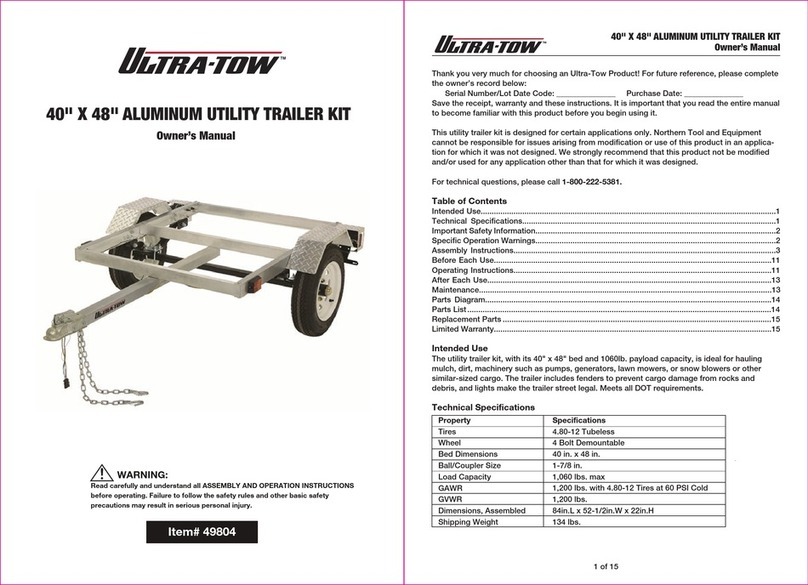TOMCAR TM37E 2018 User manual

EMERGENCY RESPONSE GUIDE
ANY WHERE AND BACK
MT
EV
100% ELECTRIC

PREFACE
1
TOMCAR™ ERG 2017
Preface
The emergency response procedures for the Electric Tomcar vehicles are similar to those for hybrid-electric
vehicles with the same considerations for the high-voltage electric system components.
Tomcar Electric vehicles use an electric motor to power the vehicle. Electricity is stored in high-voltage
battery packs. The system incorporates a generator function in the electric motor that recharges the high-
voltage batteries during cruising and braking.
The information in this guide will help provide a safe response to emergencies involving Electric Tomcar
vehicles.
The Tomcar Electric vehicle has been designed with many safety features for your protection. These
features help provide safe access to the vehicle under various conditions; however, when approaching a
high-voltage vehicle in a fire, rescue or recovery situation, always follow one industry standard rule:
ALWAYS ASSUME THE VEHICLE’S HIGH VOLTAGE SYSTEM IS POWERED UP!
This manual is a part of your TOMCAR® and should remain with the vehicle.

TABLE OF CONTENTS
2
TOMCAR™ ERG 2017
TOMCAR™ Electric Vehicle Variants.................................................................................................................. 3
High-Voltage Electrical Disconnect Features..................................................................................................... 5
High-Voltage Warning Decals............................................................................................................................ 6
Components Location and Identification.......................................................................................................... 7
High-Voltage Disconnect Switch...................................................................................................................... 12
High-Voltage Battery Pack............................................................................................................................... 13
Approaching A Damaged High-Voltage Vehicle .............................................................................................. 15
Storage Placard................................................................................................................................................ 20

ELECTRIC VEHICLE IDENTIFICATION
3
TOMCAR™ ERG 2017
TOMCAR™Electric Vehicle Variants
Two-Seater Pickup (TM37E)
Four Seater (TM47E)
Two-Seater Pickup (TM58E)

ELECTRIC VEHICLE IDENTIFICATION
4
TOMCAR™ ERG 2017
Tomcar Electric Vehicles can easily be identified by the “EV” badges located on the left and right front
fenders and rear bumper.

ELECTRIC COMPONENTS SAFETY
5
TOMCAR™ ERG 2017
High-Voltage Electrical Disconnect Features
WARNING
Electric vehicles damaged by a crash may have compromised high voltage safety systems and present a
potential high voltage electrical shock hazard.
Exercise caution and wear appropriate personal protective equipment safety gear, including high voltage
safety gloves and boots. Remove all metallic jewelry. Isolate high voltage systems as directed in this
manual. Failure to follow these instructions may result in serious personal injury or death.
The following list describes certain features that have been incorporated into Tomcar electric vehicles that
allows for either simple or automatic shut-off of the high-voltage electrical systems.
•High-Voltage Manual / Service Disconnect Switch –Any time the manual high-voltage disconnect
switch is in the ‘OFF’ position, the high-voltage system is isolated.
•High-Voltage Interlock Circuit –whenever a high voltage connector is disconnected, the high-
voltage interlock circuit opens and isolates the high voltage system. The circuit will also open when
a cable is cut, a high-voltage insulation fault is detected, a motor insulation fault is present or if the
safety mechanism safety checks discover a fault such as a welded contactor.
•Ignition in the ‘OFF’ Position –whenever the ignition switch is in the ‘OFF’ position and the vehicle
is not being charged, the high-voltage system is isolated.
•Thermal Sensors –Thermal sensors monitor the battery pack, motor controller and motor. If the
vehicle cooling or heating system is compromised, power limitations will be implemented up to
complete system shutdown.

ELECTRIC COMPONENTS SAFETY
6
TOMCAR™ ERG 2017
High-Voltage Warning Decals
Warning decals are located on components in the high-voltage system throughout the vehicle.
Please see examples below:

COMPONENTS LOCATION AND IDENTIFICATION
7
TOMCAR™ ERG 2017
Components Location and Identification
The Illustrations and definitions on pages 7 - 12, provide the location, description and basic function of the
high-voltage electric system components in all model variants.
NOTE: The high-power circuit is denoted by orange cables, orange with grey stripe wires and parts marked
by the symbol.

COMPONENTS LOCATION AND IDENTIFICATION
8
TOMCAR™ ERG 2017
TM37E
1
Electric Motor
2
Motor Controller
3
Traction Battery
4
Safety Disconnect
5
Charger Socket
6
12-volt battery

COMPONENTS LOCATION AND IDENTIFICATION
9
TOMCAR™ ERG 2017
TM47E
1
Electric Motor
2
Motor Controller
3
Traction Battery
4
Safety Disconnect
5
Charger Socket
6
12-volt battery

COMPONENTS LOCATION AND IDENTIFICATION
10
TOMCAR™ ERG 2017
TM58E
1
Electric Motor
2
Motor Controller
3
Traction Battery
4
Safety Disconnect
5
Charger Socket
6
12-volt battery
7
24-volt battery (optional)

COMPONENTS LOCATION AND IDENTIFICATION
11
TOMCAR™ ERG 2017
1. Electric Motor
3-phase AC motor is used to turn the high-voltage traction battery energy into movement
that is applied to the transmission for vehicle propulsion.
2. Motor Controller
The motor control unit provides energy efficient control of the AC motor performing on-
vehicle traction drive duties while monitoring peripheral items and maintaining highest
safety standards.
3. Traction Battery
Air cooled/heated LiFePo4 battery pack stores the energy necessary to operate the motor.
The traction battery is monitored by the energy management system and automatic cut-
backs and cut-offs are performed if required.
4. Safety Disconnect
The traction battery is equipped with a manual safety disconnect switch to cut the battery
power in case of an emergency or prior to system maintenance.
5. Charger Socket
The charger socket is connected to the high-voltage system only when the charger is
connected and a charge cycle is in progress.
6. 12-Volt / 24-Volt Battery
Typical automotive battery is used to operate auxiliary equipment and motor controller
logic circuit. It is charged from the traction battery via a DC-DC converter.

HIGH-VOLTAGE DISCONNECT
12
TOMCAR™ ERG 2017
High-Voltage Disconnect Switch
WARNING
Electric vehicles damaged by a crash may have compromised high voltage safety systems and present a
potential high voltage electrical shock hazard.
Exercise caution and wear appropriate personal protective equipment safety gear, including high voltage
safety gloves and boots. Remove all metallic jewelry. Isolate high voltage systems as directed in this
manual. Failure to follow these instructions may result in serious personal injury or death.
The high-voltage disconnect switch is located on the battery pack box in all models and is easily reached.
Turning the switch-knob counterclockwise to
the ‘OFF’ position, disconnects the high-
voltage system.

HIGH-VOLTAGE BATTERY PACK
13
TOMCAR™ ERG 2017
High-Voltage Battery Pack
WARNING
Electric vehicles damaged by a crash may have compromised high voltage safety systems and present a
potential high voltage electrical shock hazard.
Exercise caution and wear appropriate personal protective equipment safety gear, including high voltage
safety gloves and boots. Remove all metallic jewelry. Isolate high voltage systems as directed in this
manual. Failure to follow these instructions may result in serious personal injury or death.
WARNING
Fires in crash-damaged electric vehicles may emit toxic or combustible gasses. Small amounts of eye, skin
or lung irritants may be present. Wear personal protective equipment and self-contained breathing
apparatus when working in close proximity or in a confined area such as a tunnel or garage. Ventilate the
vehicle by opening vehicle doors, if equipped. Ventilate the working area. Failure to follow these
instructions may result in serious personal injury or death.
•Do not cut the high-voltage battery case. Do not penetrate the battery case in any way.
•Turning the safety disconnect switch to the ‘OFF’ position will isolate the high-voltage from
the vehicle. The battery pack will remain live and dangerous.
•The total voltage of the battery pack is approximately 110-volt DC.
•The battery case is splash proof, but not water tight.

HIGH-VOLTAGE BATTERY PACK
14
TOMCAR™ ERG 2017
•The battery cells material will not leak under most conditions, however if the battery is
crushed or penetrated it is possible for a small amount of electrolyte material to leak.
•If possible, isolate and avoid contact with high-voltage vehicle components. If contact
cannot be avoided, personal protective equipment such as splash shield, HV gloves,
overcoat and HV isolated boots are required when handling damaged batteries. In case of
eye or skin exposure, immediately flush with plenty of water for at least 15 minutes and
seek medical attention.
•Excessive heat can cause venting of hazardous decomposition products. Corrosive gas may
be emitted during fire. First responders should be equipped with a full mask and breathing
apparatus.

APPROACHING A DAMAGED HIGH-VOLTAGE VEHICLE
15
TOMCAR™ ERG 2017
Approaching A Damaged High-Voltage Vehicle
WARNING
Electric vehicles damaged by a crash may have compromised high voltage safety systems and present a
potential high voltage electrical shock hazard.
Exercise caution and wear appropriate personal protective equipment safety gear, including high voltage
safety gloves and boots. Remove all metallic jewelry. Isolate high voltage systems as directed in this
manual. Failure to follow these instructions may result in serious personal injury or death.
WARNING
Fires in crash-damaged electric vehicles may emit toxic or combustible gasses. Small amounts of eye, skin
or lung irritants may be present. Wear personal protective equipment and self-contained breathing
apparatus when working in close proximity or in a confined area such as a tunnel or garage. Ventilate the
vehicle by opening vehicle doors, if equipped. Ventilate the working area. Failure to follow these
instructions may result in serious personal injury or death.
WARNING
Damaged electric vehicles submerged in water present a potential high-voltage electrical shock
hazard. Exercise caution and wear appropriate protective equipment including high-voltage safety
gloves and boots. Remove all metallic jewelry. Do not attempt to extract the vehicle until the high-

APPROACHING A DAMAGED HIGH-VOLTAGE VEHICLE
16
TOMCAR™ ERG 2017
voltage battery has discharged. Failure to follow these instructions may result in serious personal injury
or death.
WARNING
Electric vehicles with damaged high-voltage batteries require special handling precautions. Inspect the
vehicle carefully for leaking battery fluids, sparks, flames and gurgling or bubbling sounds. Contact
emergency service immediately if any of these problems are observed. Failure to follow these instructions
may result in serious personal injury or death.
1. Follow existing training and incident commander direction
a. Emergency responders should use LARGE amounts of water if fire is present or
suspected and, keeping in mind that fire can occur for a considerable period after a
crash, should proceed accordingly.
b. This guide provides only supplemental information as it pertains to Tomcar electric
vehicles. The same rules apply when approaching any potential high-voltage
situation. Always follow your high-voltage safety training. Some precautions to take
in a high-voltage situation include:
•Remove all metallic jewelry and objects that are conductors of electricity.
•Wear the necessary PPE: personal protective equipment.

APPROACHING A DAMAGED HIGH-VOLTAGE VEHICLE
17
TOMCAR™ ERG 2017
c. Bring the following equipment:
•Class ABC powder-type fire extinguisher.
•A nonconductive object, about 1.5m long. This can be used to safely push
someone away from the vehicle if they accidentally come in contact with
high-voltage.
2. Approaching a damaged vehicle
a. Disable the high-voltage electrical system using as many of the following steps as
possible:
•Secure the vehicle: Place the ignition in the ‘OFF’ position. Pull the hand-
brake and block the wheels if necessary.
•Disconnect the negative cable from the 12-volt battery.
•Place the safety switch in the ‘OFF’ position. If the safety disconnect cannot
be reached, avoid the high-voltage components and wear appropriate PEE.
b. If the vehicle is on fire, use a Class ABC powder-type extinguisher to contain and
smother the flames. If water is being used, LARGE amounts of water will be
required to extinguish the flames. Water can cause some degree of arcing/shorting
across a cell and/or battery terminals. It can also react with the electrolyte from the
cells to generate additional combustible gas and other by-products. However, the
cooling and smothering effects of flushing the affected article with large amounts of

APPROACHING A DAMAGED HIGH-VOLTAGE VEHICLE
18
TOMCAR™ ERG 2017
water and/or fire suppression material is still beneficial for minimizing the severity
of the event.
c. If the vehicle has any exposed cables, make sure to wear high-voltage PPE. Do not
touch any broken or damaged high-voltage orange cables. Treat severed cables as if
they contain high-voltage.
d. If the vehicle is submerged in water, varying degrees of arcing/shorting within the
battery will take place. Do not touch any high-voltage components while extricating
the occupants. Do not remove the vehicle until you ae sure the high voltage battery
is completely discharged.
3. No cut zones
a. If possible, turn ‘OFF’ the high-voltage battery service disconnect switch before
attempting any extrication procedure. Always assume the high-voltage cabling and
components are powered up.
b. If cutting is necessary for occupant extrication, always use caution near the high-
voltage components and orange cabling. Cables are visible and are only present
between the battery pack and motor controller in the rear section of the vehicle.
4. If high-voltage battery case has been ruptured
a. Hose the area down with LARGE amounts of water.

APPROACHING A DAMAGED HIGH-VOLTAGE VEHICLE
19
TOMCAR™ ERG 2017
5. Moving damaged vehicles
a. Do not attempt to pull or tow he vehicle with the rear wheels on the ground as
this may cause the vehicle to generate electricity and can cause potential damage.
b. If possible, turn ‘OFF’ the high-voltage safety switch.
c. Operators of tow trucks and vehicle storage facilities should ensure the damaged
vehicle is kept in an open and well ventilated area.
d. If you detect leaking fluids, sparks, smoke, flames, increased temperature, gurgling,
popping or hissing noises from the high-voltage battery compartment, call
emergency services.
e. Be alert. There is a potential for delayed fire with damaged lithium batteries.
f. Call an authorized Tomcar dealer, if necessary, to determine additional steps that
you should take to safely recover or transport a vehicle.
g. Always approach vehicle from the sides to stay out of potential travel path. It may
be difficult to determine if the vehicle is running due to the lack of engine noise.
h. Refer to vehicle manual to locate proper attachment points and transport method.
i. Avoid contact with orange cabling and areas identified as high-voltage risk by
warning labels.
6. Battery disposal
a. Batteries are to be disposed according to local regulations.
b. Contact Tomcar dealer for additional information.
This manual suits for next models
2
Table of contents
Other TOMCAR Utility Vehicle manuals
Popular Utility Vehicle manuals by other brands
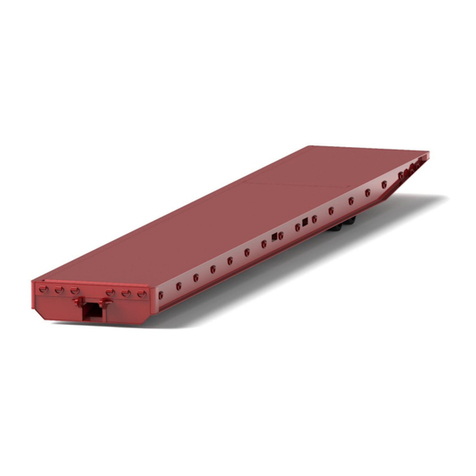
Novatech
Novatech 11.569.00-B owner's manual
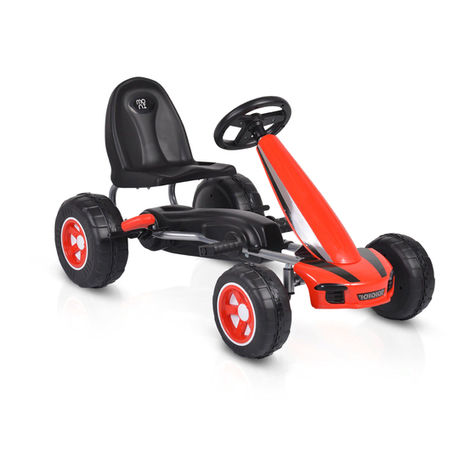
Moni
Moni FEVER Operating instructions and assembly manual

Taylor-Dunn
Taylor-Dunn B5-540-48XL Service and Replacement Parts Manual

URBANGLIDE
URBANGLIDE MONSTER user manual
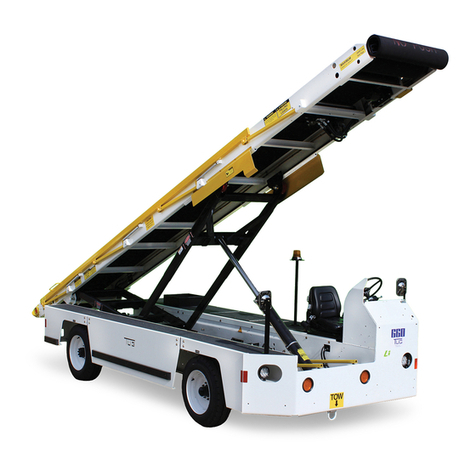
TUG Technologies
TUG Technologies 660 Operation manual
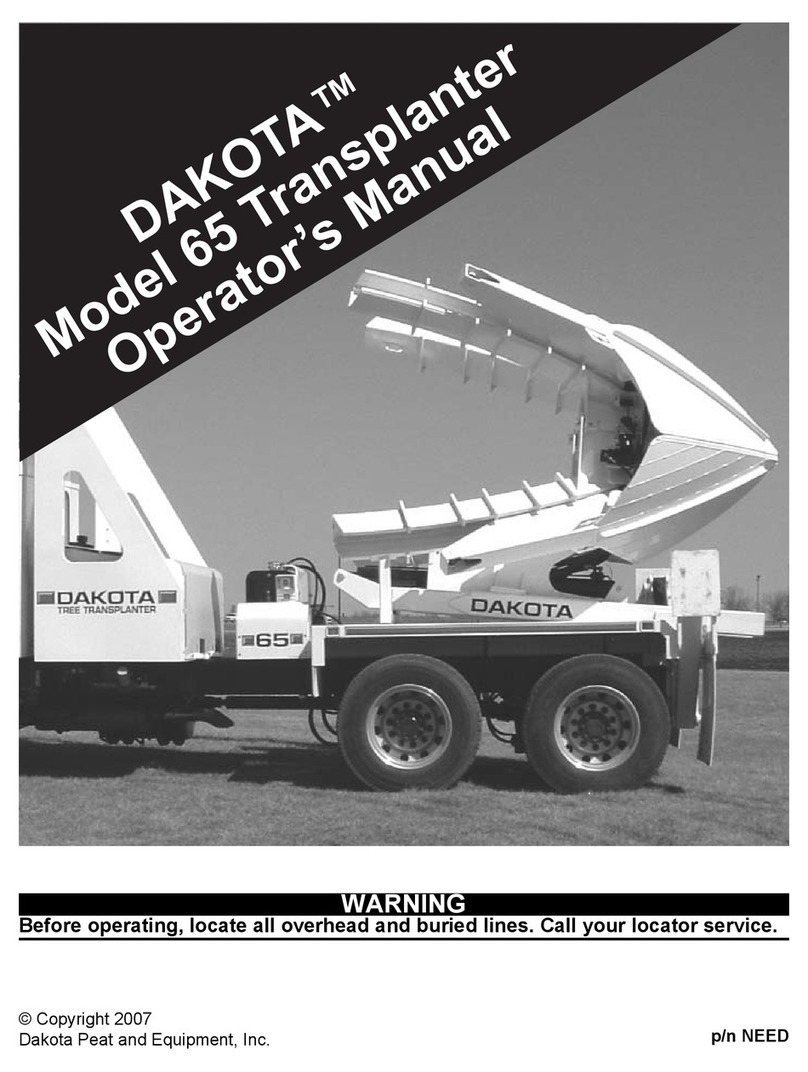
Dakota
Dakota 65 TREE Transplanter Operator's manual

